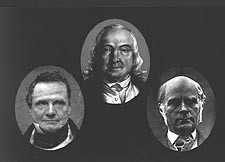
Optimum 2000
Distributed by First Run/Icarus Films, 32 Court St., 21st Floor, Brooklyn, NY 11201; 800-876-1710
Produced by Pierre-Olivier Bardet and Jacques-Henri Bronckart
Directed by Henry Colomer; An Ideale Audience & Versus Production
VHS, color, 53 min.
High School - Adult
Ethics, History, Philosophy, Science, Technology
Date Entered: 11/09/2018
Reviewed by Kristin Jacobi, J. Eugene Smith Library, Eastern Connecticut State University, WillimanticThis quirky and, at some times, sinister film co-joins three 19th century visionaries: Jeremy Bentham (1748-1832), Charles Babbage (1791-1871), and Francis Galton (1822-1911). The premise is that each independent thinker conceived a worldview philosophy. With Bentham's principles and Babbage's tool, the result is the application of genetic theory of Galton.
Optimizing human resources was the cornerstone of each man's desire and destiny. Bentham, a lawyer by schooling, was one of the founders of Utilitarianism. His principle that the 'pursuit of selfish interest by each individual leads to the common good' is the one by which he lived. Of financial means, he was able to study, reflect, and write on the theoretical questions of law. His wide range of interests led him to his theory of utility, and his ideas on punishment, pleasure and pain (maximizing happiness and minimizing unhappiness). He was an outspoken advocate of law reform, and had much to say on such diverse subjects as: prison reform, religion, poor relief, international law, and animal welfare.
Bentham's major philosophical work, An Introduction to the Principles of Morals and Legislation (1789), was designed as an introduction to a plan of a penal code. Bentham devised a floor plan of a building that would be circular in shape, a Panopticon. Architecturally, it would facilitate a maximum of view for surveillance, with a minimum of effort to control the inmates. Although this structure was not built during Bentham's lifetime, it became the blueprint for the prisons in the United States.
In his last testament, Bentham declared that his skeleton be dressed in one of his suits and his corpse seated in one of his chairs. This "Auto-Icon," as he called it, sits a wooden cabinet, and can be found at the end of the South Cloisters of the main building of the University College London.
The second eccentric intellectual in this film, Charles Babbage (1791-1871), has an extraordinary range of achievements to his credit: he was a mathematician, a computer pioneer, an economist, a mechanical engineer, a decipherer (code-breaker), an inventor, and a prominent figure in his current society.
Babbage's greatest achievement was the detailed plans for Calculating Engines, both the table-making Difference Engines and the far more ambitious Analytical Engines. These ‘engines’ were elaborate machines that were flexible and powerful, and could perform mathematical operations mechanically, rather than manually. One of his Analytical Engines was a punched-card controlled general-purpose calculator that embodied many features. This punched-card calculator was the precursor of the modern-day computer. It has often been asked whether Babbage’s Engines would have worked if they had been built (!) during the 1850s.
Francis Galton (1822-1911) was an English scientist and the founder of eugenics, and parenthetically, a cousin of Charles Darwin. Galton was wealthy enough to be able to turn all of his exceptional intelligence to studies that interested him. He explored in Southern Africa, and he introduced the theory of the anticyclone to meteorology. In his landmark study, Hereditary Genius (1869), Galton presented strong evidence that talent is an inherited characteristic by tracing ‘ability’ through family heredities. Galton had introduced the very word "eugenics" in this study.
Galton established a system of classifying fingerprints that is still used today.
Galton transformed the study of ability into a science by applying statistical methods to the data he collected. During this process, he studied the nature of genetics versus the nurture of the environment. By studying a person’s DNA, scientists are able to discover to what extent their genes are responsible for any disease, and to what extent their lifestyle is the cause. This sophisticated field of study is now called behavior genetics. Galton was also the first to suggest the study of twins to disentangle the effects of heredity and environment.
The formulation of 'eugenics,’ which seeks to improve the human stock or prevent the degeneration of genetic potential, was at the forefront of Galton’s most ambitious work.
Although he had no intention to change how the world viewed the social sciences, there are few aspects of modern social science that do not rely on the statistical innovations that Galton introduced.
Screened at the 20th Annual Vancouver International Film Festival 2001, this film's unhurried pace and, sometimes, haunting music create an unusual backdrop for the principles, methods, and lives of these three radical visionaries in the crusade of efficiency.
The subject and intellectual content is for juniors and seniors in high school, and up. It is an absorbing and thought provoking film and recommended for very large high school collections, or college and university collections.